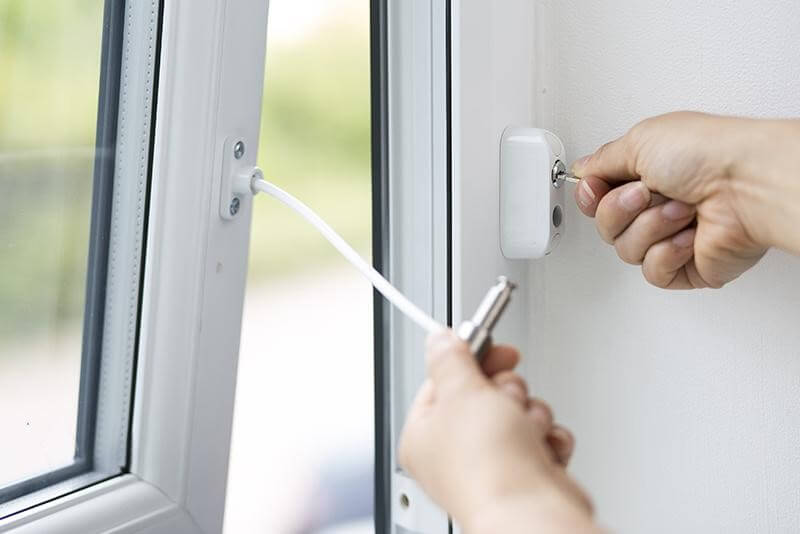Natural ventilation is a key concern in Australia due to the nation’s warm climate. An open window offers a cool breeze, but it also poses a risk to children. Here’s what you need to know about window safety and security standards.
As the temperature rises, your house can feel like an oven. Warm, trapped air creates sweltering conditions. An air conditioning unit may alleviate the problem, but it also costs money. It also doesn’t offer the natural ventilation that your home needs.
Well-placed windows offer the cost-free solution. Cracking open a window lets cool air travel through the home. If you can create a cross-breeze, a warm home cools down in a matter of minutes.
That’s sweet relief on a hot day. But such relief also presents window safety issues.
In early 2017, two young children found out about those issues first-hand.
While playing in a Bankstown apartment, the duo fell out of a window. They plummeted 10 metres to a concrete floor below.
Luckily, the younger of the two children escaped the incident with minor injuries. However, the elder child, aged five, landed directly on the pavement outside the apartment. The resulting life-threatening injuries are a stark reminder of the dangers of windows.
All of this happened from the supposed “safety” of an apartment. In a matter of moments, two children playing turned into a near-fatal accident.
The incident prompted a police investigation and cast a spotlight on the issue of window safety. Even with all of the current building codes in place, it’s still a concern for many Australians.
This isn’t an isolated incident either. In February 2018, a seven-year-old boy suffered similar injuries after falling out of a window. Unsettlingly, the incident also occurred in an apartment unit in Bankstown.
The child suffered critical head injuries, and police are currently investigating the incident.
Such incidents suggest that there’s a problem with window safety in Australia. It may be that designers and builders aren’t following regulations. Or, the speed of apartment construction, especially in cities like Sydney, is so fast that oversights occur.
The Scale of Window Safety Issues
Falls from windows affect children in every country. In 2011, American researchers examined the true scale of the problem in the United States. They discovered that over 5,000 children fall out of windows in the country every year.
Australia has much stricter window safety standards than the United States. Nevertheless, approximately 50 children fall out of windows in the country annually. Some of these incidents end in the deaths of the children involved.
Such falls occur because many don’t recognise the danger that open windows present. Absent-mindedly opening a window to let a breeze in may seem innocent enough. But you create the potential for serious injury if you have children in the house. If you live in a high-rise apartment, the risk increases.
The Risk Factors to Watch Out For
As you can see, children falling out of windows is still a problem in Australia. It’s perhaps even more of an issue when taking your children travelling. These are the main risk factors to watch out for.
- Windows With No Locks: Children aren’t always safe once you’ve closed the window. If it has no locks, anybody can open it. You may not think that your child can undo a complex window mechanism. However, without a lock, there’s always the possibility that it may happen.
- No Control: You may partially open a window to improve natural ventilation. However, some windows don’t allow you to lock them in a certain position. If a child pushed against the glass, the window opens wider. Children are at risk if you have no control over how far the window opens.
- Low Windows: The closer a window is to the ground, the easier it is for a child to access it. Some home and apartment designs make heavy use of windows. A few even contain floor-to-ceiling windows. These present the largest risk of all to adventurous children.
- Glass Strength: Weak glass can’t survive heavy impacts. You may not think that children can generate enough power to shatter a glass pane. But it only takes a single throw of the right item, such as a golf ball, to shatter weak glass. Even seemingly innocuous items present a risk to weak glass.
What Measures Are in Place to Improve Window Safety?
The National Construction Code (NCC) dictates the measures that are in place for window safety.
The most recent changes to the NCC took place during 2019. They specified new requirements for windows in new residential properties and childhood centres.
The obvious issue here is that these requirements only relate to new buildings. Residential properties built before 2019 may still have unsafe windows.
What are the Current Requirements of Window Safety?
Locking mechanisms took centre stage with the most recent NCC changes. All new windows must now have a device installed that restricts how far they open. Failing that, the windows must have a suitable screen in front of them. In both cases, you must not be able to fit a sphere with a 12.5cm diameter through the opening. The NCC chose this measurement as it is below the approximate diameter of a young child’s skull.
The screen or device may have a release mechanism built in. This allows the screen or window to open further. However, this must be a child-resistant mechanism. If the window includes such a mechanism, there must be a barrier below the window.
This barrier must be a minimum of 86.5cm high. It also must not allow the previously mentioned sphere to pass through it. Furthermore, it cannot include horizontal elements that allow children to climb up to the window. In most cases, a wall acts as such a barrier. However, you may use fixed glass, as long as it meets certain strength requirements. Window and barrier glass must be able to absorb a 250N horizontal forced without shattering. This covers the force that a child may be able to generate if he or she runs into the window.
However, this barrier is not required in cases where the screen or device has a fixed position. Such screens and devices usually require power tools, such as a drill for removal. They’re also considered fixtures rather than child resistant mechanisms.
Finally, the window needs no such protective measures if the lowest part of its opening stands 1.7m or more from the surface beneath.
Explaining the Term “Child Resistant”

The code uses the term “child resistant” to describe allowable release mechanisms. You may wish to install one for several reasons. These include easier window cleaning or fast removal in the case of an emergency.
In this case, a child resistant mechanism is any of the following:
- A mechanism that needs unlocking with a key before removal.
- Any mechanism that requires two hands to release.
- Mechanisms that need basic handheld tools, such as a spanner or screwdriver, for release.
Beyond meeting these requirements, the mechanism must conform to the NCC’s standards. This means it doesn’t allow the window to open beyond 12.5cm when in place. It must also be able to withstand a 250N force.
Explaining the Term “Surface Beneath”?
The term “surface beneath” describes the surface directly below the window. In most cases, this is a floor, with usually a wall rising up from it. This wall typically creates the barrier mentioned earlier.
However, some builders question the term as it relates to roofs and ledges. They wish to know if such surfaces get classed as “surface beneath” too.
It’s a contentious issue. A surveyor or building certifier will usually make a judgement on a case-by-case basis.
However, keep in mind that the “surface beneath” proviso protects young children. If the child can still fall to a surface below from the “surface beneath”, it’s not a suitable surface. In such cases, roofs and ledges without proper barriers would not be suitable as the “surface beneath” a window.
The Effects of These Measures on Ventilation Standards

These measures all sound fine, and they contribute to the low number of window falls that occur in Australia.
However, restricting how far a window opens could conflict with modern ventilation standards.
According to the Building Code of Australia (BCC), habitable rooms must have natural ventilation. This can come from one of the following sources:
- Doors
- Windows
- Permanent openings
What’s key here is the combined openable size of these natural ventilation sources. Combined, they must equal a minimum of 5% of the room’s floor area.
This requirement raises questions about the restrictive devices used for new windows.
However, it’s not usually an issue. The BCA’s measures only require the window to open. They don’t say exactly how much it should open. When combined with doors and other openings, 12.5cm works well for most rooms.
Furthermore, windows can also still open all of the way upon removal of the restrictive device. As a result, the NCC measures for window safety do not conflict with the BCA measures for natural ventilation. This also means that window safety measures do not have a negative effect on energy efficiency.
What Other Safety Measures Can You Take?
Those are the main safety standards that modern Australian windows must meet. However, it’s important to note the restrictions of these measures. They only apply to residential properties and childcare buildings. As a result, builders don’t have to meet them for office blocks or similar commercial properties.
Furthermore, older residential properties often don’t have these measures in place. As a result, you may wish to take further measures to protect against falls from windows.
These may include any of the following:
- The installation of new windows, such as louvre windows. The horizontal slats in louvre windows offer safety without any compromise to natural ventilation. They prevent young children from fitting through the window space, while maximising air flow from outside.
- Planting bushes and other plant life directly outside the louvre window. Some experts believe that bushes have a cushioning effect that may prevent serious injuries in some falls. However, you may not be able to do this if your window points out towards a road or pavement.
- Keeping furniture and other climbable items away from the windows. Adventurous children may use such items to gain access to a window. This can even happen if you meet the NCC’s barrier guidelines.
- Using adequate screens. Fly screens, curtains, and blinds don’t offer enough protection. They certainly can’t withstand 250N of horizontal force.
- Educating children about the safety concerns related to playing near windows. Installers can remind parents to tell their children about the dangers.
- Installing window safety devices on any windows that don’t already have them. This accounts for windows installed prior to 2019.
The Final Word
Though there are measures in place to prevent it, falling out of windows still happens. Children are at risk whenever they’re near windows that don’t meet the safety measures outlined above. Older buildings, in particular, require re-examining to bring them up to modern standards.
The team at Safetyline Jalousie can help you if you need windows that meet the NCC safety standards. Our selection of louvre windows meets or exceeds all current building codes. Furthermore, they solve the natural ventilation issues that some may find as a cause for concern.
Call us today to discuss your requirements with one of our business managers. They can provide more information about our louvre windows’ specifications. They’ll also help you find and order the right windows for your project.
References:
1. New Standard for Fall Prevention from Openable Windows – Engineers Australia
2. Window fall-related injuries among youth examined – ScienceDaily























